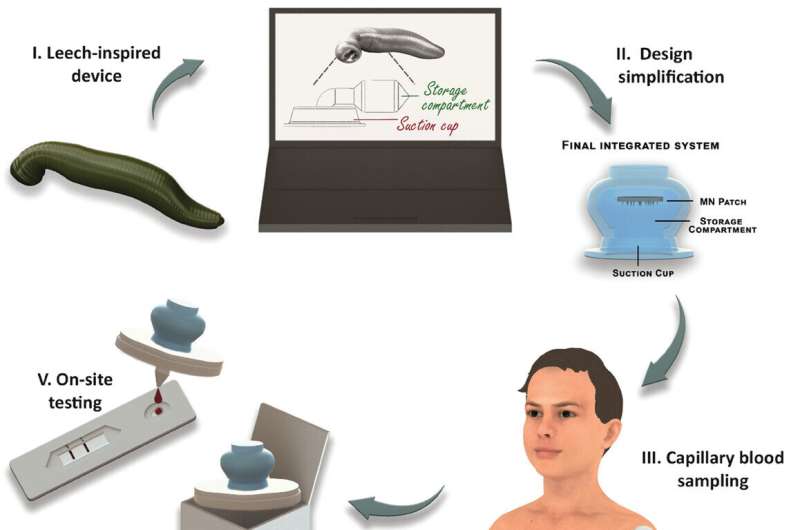This article has been reviewed according to Science X's editorial process and policies. Editors have highlighted the following attributes while ensuring the content's credibility:
fact-checked
peer-reviewed publication
trusted source
proofread
Blood diagnostics device modeled on leeches could be use to detect malaria

Researchers at ETH Zurich have developed a safe and inexpensive device for reliable blood measurements. It works using a suction cup and could also be employed to diagnose the tropical disease malaria—even by non-medical personnel. The study is published in Advanced Science.
Many people are afraid of needles, and having a doctor take a blood sample from their arm makes them uncomfortable. There is an alternative: a prick to the fingertip or earlobe. But for many laboratory tests, the drop of blood that can be obtained from these places is not enough. Above all, however, tests done with them are often inaccurate: laboratory values fluctuate from measurement to measurement.
Researchers at ETH Zurich have now developed a new device for taking blood samples. It works according to the leech principle and is less invasive than taking blood from the arm with a needle. It is also easy to handle and can be used by people without medical training. Although the new device cannot collect as much blood as a needle, it can collect significantly more than a finger prick. This makes diagnostic measurements more reliable.
Low risk of injury
The ETH researchers came up with the idea for the new device while previously developing something else: a suction cup that transports medication into the blood via the mucous membrane lining the inside of the mouth.
"For this earlier project, we had already studied leeches, which attach to their host with a sucker. We realized that we could develop a similar system to collect blood," says David Klein, a doctoral student in the group led by Jean-Christophe Leroux, Professor of Drug Formulation and Delivery at ETH Zurich.
After leeches have attached themselves, they penetrate the host's skin with their teeth. To suck blood from the wound, they create negative pressure by swallowing. The new device works in a very similar way: A suction cup measuring about 2.5 centimeters is attached to the patient's upper arm or back.
Within the cup are a dozen microneedles that puncture the skin when pressed against it. Within a few minutes, the negative pressure in the suction cup has ensured that sufficient blood has been collected to be used for diagnostic tests.
The new device is very cost-effective to produce, says Nicole Zoratto, a postdoc in Leroux's group. She led the work on this development and is lead author of the study. Zoratto also sees a future application for the new device in low-income regions such as sub-Saharan Africa, where it could play a major part in the fight against tropical diseases such as malaria. Diagnosing malaria involves taking blood from the patients.
Another advantage of the new device is that the microneedles are located within the suction cup. This minimizes the risk of injury during the application and after disposal compared to blood sampling with conventional needles.
In the current version of the leech-like device, the suction cup is made of silicone and the microneedles concealed within are made of steel. However, the researchers are in the process of developing a new version made using fully biodegradable materials to create a sustainable product.
The researchers have tested their new device on pigs, and they have made comprehensive manufacturing information.
Before the device can be widely used on humans—in malaria regions and elsewhere—the material composition still needs to be optimized. And above all, safe use must be tested with a small group of test subjects.
As such studies are complex and expensive, the research group is still looking for a partner for further funding, for example a charitable foundation. They hope that their new leech devices will soon be able to play a part in the health of children and anyone else who is afraid of needles.
More information: Nicole Zoratto et al, A Bioinspired and Cost‐Effective Device for Minimally Invasive Blood Sampling, Advanced Science (2024). DOI: 10.1002/advs.202308809



















